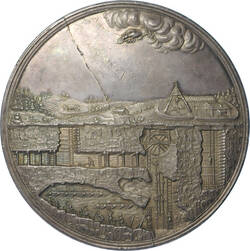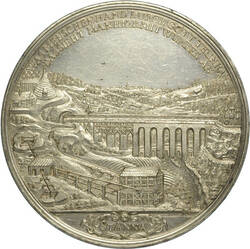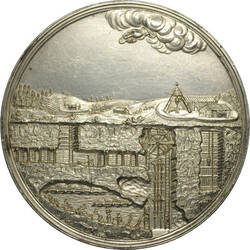Saxony's mining industry features in many artistic representations, including medal design.
Mining medals were minted for a wide range of different reasons. Medals celebrating production output (known as "Ausbeutemedaillen", literally yield medals) were very important. If the yield had been particularly rich, Saxony's rulers would issue these medals in place of the usual coins. The aim was to allow the pit's shareholders, the members of a mining association, to share in the yield in a decorous fashion. At the same time, the medal served as encouragement to work on tirelessly.
In total, the Dresden Mint issued four such yield medals. The one you see here is considered the most important artistically: the medal for the St. Anna and Altväter mine designed by Martin Heinrich Omeis in 1690.
On the obverse, you can see the Altväter Bridge. It was a major engineering achievement of its day, erected between 1653 and 1689 in Rothenfurth not far from Freiberg. The bridge, which has not survived, was originally an aqueduct carrying the Münzbach stream across the Mulde river valley. The water was needed to power the machinery. The obverse shows the mining complex above ground, while the reverse shows the underground workings.
Take another moment to look at the top edge, where you'll notice a hand emerging from a cloud. It symbolises what's known as the "Zubuße", or subsidy, an investment without which mining would not have been possible.
The medal had a value of 10 Speciesthalers – this was the name for the Reichsthalers in Saxony after the convention of Zinna in 1667, when a new monetary standard was introduced. Fewer than 90 medals were struck.
Further Media
- Location & Dating
- Saxony, 1690
- Material & Technique
- Silver, embossed, reverse with stamp crack
- Dimenions
- Diameter: 80,8 mm; weight: 235,048 g
- Museum
- Münzkabinett
- Inventory number
- BGB1242


